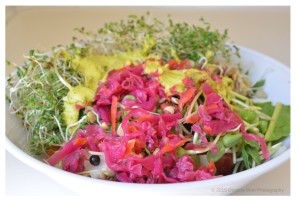Did you know that our bodies contain 10 times more bacterial cells than our own bodies’ cells?¹ Yes—we actually have more bacterial cells in our bodies than the cells of our bodies! While knowing this fact may make your skin crawl, the truth is, we need these bacteria for important functions in our bodies, ranging from digestion to the production of essential vitamins.
Not only do bacteria help us to break down the foods that we eat, which aids tremendously in our digestion, but they also produce vitamins K, B-12, and D, which are essential to our health. Additionally, bacteria like Lactobacillus and Bifidobacteria can actually prevent the formation of tumors, so they also have an anti-cancer activity. That is the reason why having these helpful forms of bacteria, or probiotics, especially within our digestive systems, is critically important to our health. However, we encounter many challenges that destroy the fine balance of these microbes within our bodies.
The frequent use of antibiotics destroys not only bad bacteria, but also good bacteria, which over the long term, can result in an imbalance in our gut flora of microbes. For example, Methicillin-resistant Staphylococcus aureus infection, more commonly known as MRSA infection. This is caused by a strain of Staphylococcus bacteria that has become resistant to the antibiotics commonly used to treat ordinary infections. Without the right balance in gut flora, bad bacteria can grow uninhibited, which can lead to dire consequences. For example, bacteria such as Bacteroides and Clostridium have been shown to increase the rate of tumor growth.
Another challenge is the prevalent use of antibacterial soaps products that have flooded the marketplace, which have contributed to bacteria evolving to become resistant to antibiotics. Triclosan, which is a chemical agent found in antibacterial soap, can disrupt the endocrine system, which directly impacts the thyroid and hormonal system, changing the levels of estrogen, progesterone, and testosterone in the body, which has the potential to lead to the development of hormonally-sensitive cancers.
To counteract these challenges to the fine balance of bacteria that outnumbers our bodies’ cells, it is important to ensure that good bacteria within our bodies are replaced. One of the easiest ways to do this is through consuming fermented foods, such as sauerkraut or kimchee. While many commonly think of yoghurt for their source of probiotics, it is usually pasteurized, which destroys much of the good bacteria and all of the enzymes. Likewise, cooked sauerkraut no longer contains myrosinase, an enzyme, because, like all enzymes, it is destroyed by heat.
One good way around this is to make raw sauerkraut. The fermentation of raw cabbage occurs through a process called lacto-fermentation from lactobacilli, good bacteria that exist naturally on the surface of the cabbage leaves. Lactobacilli convert sugars into lactic acid. In fact, it is this acid that gives sauerkraut its characteristic tangy flavor and acts as a natural preserve to inhibit the growth of harmful bacteria.
Cabbage is classified in the brassica or cruciferous family of vegetables like kale, brussel sprouts, broccoli, and cauliflower. What is interesting is that it contains glucoinsolates, which is what gives cabbage its pungent character. Glucoinsolates are a large group of sulfur-containing glucosides, which are molecules derived from glucose.² The only way to release glucoinsolates for our digestion is for myrosinase in the cabbage to convert glucoinsolates into isothiocyanates, which actually prevent and fight cancer. In fact, allylisothiocyanate is one particular type of isothiocyanate which has been shown to reduce the risk of cancers such as bladder, breast, colon, and prostrate cancer.³ It is important to consume these vegetables raw, or just lightly steamed at most, because cooking these vegetables will completely destroy myrosinase, as well as all the other enzymes present.
So, to get you started on maintaining a healthy balance of bacteria in your body, try out this healthy and tasty raw sauerkraut recipe below!
Sources:
- MacDougall, Raymond (13 June 2012). “NIH Human Microbiome Project defines normal bacterial makeup of the body”. NIH. Retrieved 2012-09-20.
- ”Glucosinolates: Bioavailability and Importance to Health.” International Journal for Vitamin and Nutrition
- “Sulforaphane Absorption and Excretion Following Ingestion of a Semi-Purified Broccoli Powder Rich in Glucoraphanin and Broccoli Sprouts in Healthy Men.” Nutrition and Cancer DOI: 10.1080/01635581.2011.523495
Raw Vegan Sauerkraut Recipe
Here’s an easy recipe for you to create and experience a tasty way to ensure a good balance of bacteria in your body so that you can continue to function and feel your best!
Ingredients:
1 head green cabbage, sliced thinly
1 head red cabbage, sliced thinly
2 carrots, shredded
1/2 red onion, sliced
1 fennel bulb, sliced
3 cloves garlic, minced
1 green chile, minced
1/2 cup scallions
1 tablespoon ginger, minced
1.5 tablespoon sea salt or himalaya salt
3-4 fresh sprigs of dill
3 tablespoon juniper berries
1 tablespoon caraway seeds
1/2 tablespoon fennel seeds
1 teaspoon mustard seeds
Directions:
- Combine all ingredients into a clean glass bowl.
- Add salt throughout all the layers and massage thoroughly, squeezing throughout to release the juices.
- When the cabbage becomes limp, stuff firmly into two quart size mason jars, ensuring that there are no trapped air pockets. The vegetable mixture should be completely submerged under its juices.
- Fill the jars until the liquid is just 1 inch below the top of the jar. This is important to allow space for the gasses produced from the fermentation process to expand.
- Cover and leave at room temperature, ideally between 65-75 degrees fahrenheit, for 7-10 days. If the temperature and humidity are higher, it may take only 3 days. You may open the jar to release some of the gasses.
- After enough fermentation has occurred, place in refrigerator, where it can store for 3 months.
Ready to make your health a priority? Contact me here to schedule your consultation.



Deanna
Great post, and so true! Thanks you!
Dorothy,
Glad you like it! Enjoy the recipe too! 🙂